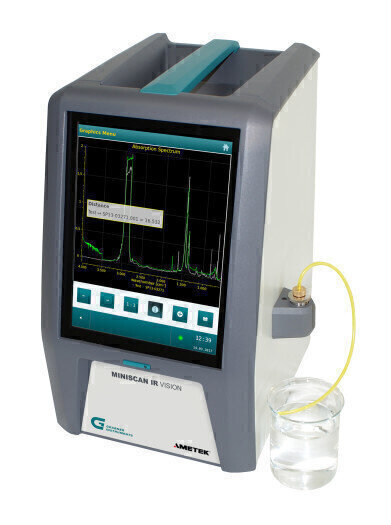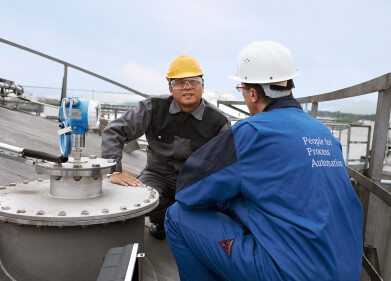-
 With the MINISCAN IR VISION FTIR analyzer, Grabner Instruments is reshaping Fourier-transform infrared spectroscopy
With the MINISCAN IR VISION FTIR analyzer, Grabner Instruments is reshaping Fourier-transform infrared spectroscopy
Analytical Instrumentation
Grabner Instruments Updates its FTIR Analysers to Meet the Ever-Growing Complexity of Fuel Composition.
Feb 16 2018
From the very beginning of fuel characterisation, infrared spectroscopy was widely applied in fuel analysis. AMETEK Grabner Instruments, an industry innovator with its IROX 2000 and MINISCAN IRXpert fuel analysers, released in 2017 its latest product, the MINISCAN IR VISION FTIR analyser.
Fuel, be it gasoline, diesel or jet fuel, consists of a complex mixture of hydrocarbons, many of which have no characteristic absorption in the IR. They constitute the “matrix” or “background.” In contrast, aromatics, olefins and the many additives used to compose a fuel show absorption bands and are used to characterise it. The content of aromatics, such as benzene, is strictly monitored by authorities, and IR standard procedures exist to assess their concentrations, for example ASTM D6277 or ISO EN238.
The number of additives used to enhance fuel properties also requires regulation, firstly for optimised blending and secondly for environmental reasons. Various components that enhance the oxygen content and foster a better combustion have been developed, and, since the chemical bond between oxygen and carbon atoms is nicely accessible with IR radiation, IR spectroscopy has become the method of choice to detect such substances (for example, ASTM D5845). The US Environmental Protection Agency (EPA) currently lists close to 7,400 different branded substances from different vendors that are used as fuel additives.
Usually, a well-defined number of specific additives are used to fine tune important fuel characteristics, such as the octane number (or cetane number in diesel fuel). Over time it became evident that the spectrum of a fuel must have a correlation with typical additives determining its properties. Since the standardised methods for obtaining information about fuel properties are time consuming and expensive (for example, CFR Knock Engines), chemometric methods linking the IR method with fuel properties became popular.
In the 1990s, Dr. Werner Grabner, founder of Grabner Instruments in Vienna, Austria, developed the IROX, the first portable FTIR spectrometer, to measure the concentration of oxygenates in gasoline through the use of mid-IR. Another instrument that specialised in diesel followed in 2000. Both instruments were used to measure concentrations of different fuel components, as well as predict classic fuel properties, by developing a robust prediction model for various regions around the world.
Still, in the first decade of the 2000s, the producers of classic benchtop IR analysers identified the fuel market as a new business area and developed similar specific applications for fuel analysis. These manufacturers also applied Raman IR spectroscopy as complement to classic IR. Other technologies, like attenuated total reflection (ATR) IR spectroscopy, were introduced. FTIR, Raman and ATR technologies, however, are essentially different ways to look at the same thing from slightly different angles. No method was better or worse than another. Each technology briought its own merits and drawbacks for the purpose it is applied for. ATR was easily applied in process for online applications; FTIR instruments were typically compactly and robustly designed for use in mobile fuel labs. The actual differentiators come from ease of use, available support, flexibility and application range, quality of instrument design, robustness, and, finally, the precision and accuracy of the device, which are direct functions of spectrometer design, its resolution, stability, the spectral range and intensity of the IR light source.
The need for more
As the oil market evolved and fuel compositions became more diverse, a demand was created for a flexible, rather than specialised analyser. This trend to versatile fuel composition remains strong today. On one side, fuel technology strives for ever more efficient fuels with better combustion and ever higher energy efficiency, and, on the other side, environment demands for low-emission fuels with a minimum of environmentally controversial substances in the exhaust.
This is why in 2017, 17 years after the launch of the IROX, Grabner Instruments released a powerful, versatile FTIR spectrometer, the MINISCAN IR Vision. The MINISCAN IR VISION is a high speed, compact and robust FTIR fuel analyser for the comprehensive and automatic measurement of gasoline, jet and diesel fuels. The analyser is configured to measure more than 100 fuel parameters and components for fuel blending. It is designed to perform quality inspection and check compliance with fuel specifications directly at the point of sale.
Compound Analysis is performed according to international standards: ASTM D5845 for oxygenates, ASTM D6277 and EN 238 for benzene, and EN 14078 for biodiesel blends. A built-in temperature-regulated density meter allows for exact determination and stability of fuel density. Octane and cetane number, distillation, vapor pressure and other fuel properties are automatically determined from the full IR spectrum, using Partial Least Square (PLS) analysis and advanced chemometric models, following ASTM E1655. Several thousand data points are used to achieve best prediction accuracy.
The MINISCAN IR Vision portable fuel analyser is unmatched in its class. The thermoelectric temperature regulation of the instrument´s filling system, measuring cells and integrated density meter maximises accuracy in measuring volume and mass percent of fuel compounds.
The instrument’s durability makes it ideal for the challenges encountered during field or mobile testing. The MINISCAN IR Vision incorporates Grabner Instrument’s proven, robust and bubble-free metal filling system. The instrument is protected by a shock-and-vibration-tested Vision platform housing. Its double interferometer is mounted with a self-aligning mirror system that allows automatic correction of intensity shifts after a rough drive over a bumpy road. A robust, 10” full-color industrial touchscreen guarantees highest visibility and ease of use even under rough environmental conditions. For field use, the instrument can be run off a 12V car adapter.
Digital Edition
PIN 25.1 Feb/March
March 2024
In This Edition Safety - The technology behind the ION Science Tiger XT - Safety with ammonia and LOHCs as hydrogen carriers Analytical Instrumentation - Discussion on new tribology te...
View all digital editions
Events
Apr 22 2024 Hannover, Germany
Apr 22 2024 Marrakech, Morroco
Apr 22 2024 Muscat, Oman
Apr 22 2024 Rotterdam, Netherlands
Apr 23 2024 Singapore

















